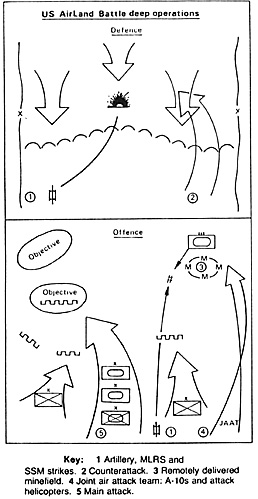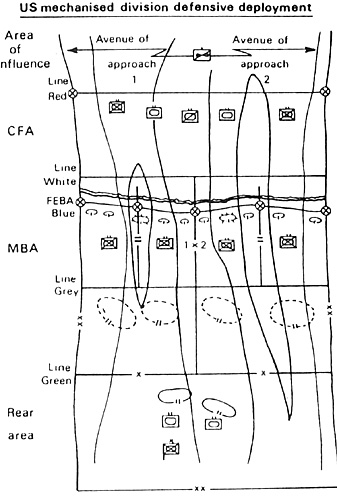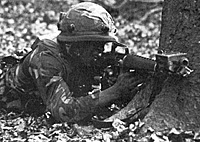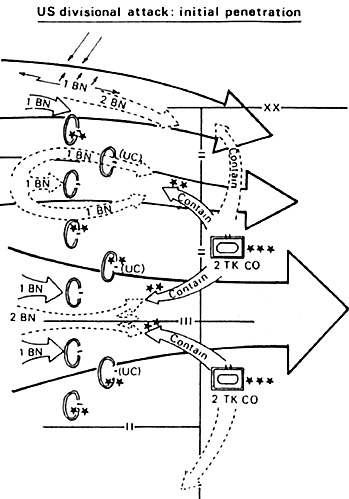
The latest U.S.Army doctrine is the AirLand Battle. It is the result of ten years of analysis of the active defense and other doctrines, observations of the Arab-Israeli wars, and the latest Soviets developments. It is based on an integration of air and land assets across a spectrum of the battlefield, a reorganization of the Army division, and the introduction of several key items of equipment.
Key: 1 Artillery, MLRS and SSM strikes. 2 Counterattack. 3 Remotely delivered minefield. 4 Joint air attack team: A-10s and attack helicopters. 5 Main attack.
AirLand Battle addresses a nonlinear battlefield, with nuclear and chemical weapons tactically integrated throughout its depth. The battle is to be extended in depth by the employment of long range weapons deep into enemy territory. Land and air forces will work closely together to achieve key strategic, operational, and tactical objectives.
The U.S. Army division has been reorganized from the ROAD organization (series H) Table of Organization and Equipment [TO&E] to the Division 86 J series TO&E. The new organization has since been renamed the Army of Excellence (AOE). The basic triangular structure for brigades remains intact. The battalion, however, no longer has three line companies, a combat support company, and a headquarters company. An AOE battalion has four line companies, a separate anti-tank company, and a reorganized headquarters company. The companies comprise three line platoons of four Armored Fighting Vehicles (AFVs) each. In the case of light, airborne, air assault, or ranger infantry units, the platoons have three squads. This organization allows the battalion commander to task organize for a defense in depth of a relatively wide sector and, if necessary, still maintain a reserve.
The U.S. brigade commander cross-attaches companies between armor and mechanized infantry battalions to create task forces. The task force commanders then task organize within the battalion. Platoons are cross-attached between tank and infantry companies. Battalion assets can also be attached to company teams. Additionally, the anti-tank company headquarters can be organized into a fifth company team by attaching tank or mechanized infantry platoons. This task organization allows the commander to tailor his force for the assigned mission and create a completely integrated combined arms team. With four or five company teams, the task force commander has increased flexibility to perform his mission.
Several new weapons systems are now being fielded. The AFVs include the M1 Abrams main battle tank, the M2 Bradley infantry fighting vehicle, and its clone, the M3 cavalry fighting vehicle. The artillery is receiving new types of ammunition and the new self-propelled multiple rocket launcher (MLRS). Air defense systems are being upgraded at all levels, although the recent demise of the Sergeant York has delayed the replacement of the Vulcan. Aviation units are receiving the UH-60 Blackhawk utility helicopter. The integration of these and other new weapons is critical to the proper execution of the AirLand Battle doctrine.
The vehicle mix of M1s, M2s, and M3s gives the U.S. commander a force with superb mobility and speed, outstanding firepower, and excellent armor protection. The task force commander must still plan around the slower elements. The M113 series of vehicles will remain in the battalion in several capacities - the anti-tank company, mortar platoon, and headquarters section all utilize M113-based vehicles. Regardless, the capabilities of the U.S. battalion task force are at an all time high.
The AirLand Battle doctrine divides the battlefield into five separate sectors, ranging from deep in friendly territory to deep in enemy territory. They are
- 1. Rear Area Battle Area - this sector will be occupied by
support units and strategic reserves. Doctrine for rear areacombat
operations exists; but, by design, enemy units will notpenetrate into
it.
2. Reserve Battle Area -this sector will contain reserve units capable of meeting enemy breakthroughs, defeating them, and counterattacking. Land force will dominate the action in this sector.
3. Main Battle Area - this sector will see combat between the units occupying defensive positions along the forward edge of the battle area (FEBA) and attacking enemy units. Combat here will be conducted by a combination of land and air forces.
4. Covering Force Battle Area - this sector is directly in front of the main battle area where the covering forces (cavalry) screen and tempt to destroy the Soviet first echelon as well as identify the axes of the main Soviet efforts. Combat in this sector will be dominated by air forces.
5. Deep Battle Area - this sector lies beyond the covering force battle area into the enemy rear. Following Soviet echelons and support units will be engaged in this sector and destroyed by long range corps level assets. As expected, this sector will be dominated by air power.
Defensive
The U.S forces in Europe will find themselves initially on the defensive in the war. The U.S. Army uses a defensive posture to destroy enemy forces, control key terrain, gain time to prepare for offensive operations, or to economize forces in one area to allow concentration in another. The U.S. concept of defense is characterized by the use of initiative, depth, agility, and synchronization. The defender must wrest the initiative away from the attacker, maintain a defense in depth, and use fire and maneuver while coordinating all available resources into an effective defensive force.
The defense against attack is divided into four parts: the deep battle beyond the corp's forward line of own troops (FLOT), the covering, force area from FLOT to FEBA, the main battle area from FEBA to the rear of the brigade sector, and the rear area behind the brigade sector. These four areas correspond to the five sectors of the AirLand Battlefield, with the reserve battle area being divided between the main battle area and the rear area.
The deep battle is the responsibility of corps or division. The deep battle includes air interdiction missions, electronic warfare, nuclear and chemical attacks, artillery and missile fire, and spoiling attacks by maneuver units, including attack helicopters. The deep battle may initially be directed at the first echelon of the enemy attack, but it will shift to the second and third echelon as the battle progresses.
The covering force battle is a corps responsibility. The purpose of the covering force, if one is established, is to provide security, delay the enemy attack, attrit or destroy the first echelon and force the enemy to reveal his main efforts. The covering force must strip away the enemy reconnaissance elements, force the enemy to bypass its position, and defeat any hasty attacks. The covering force also acts to screen the location and strengths of units in the main battle area. These actions must take place forward enough to allow the forces in the main battle area time to react to the information gained. The covering force usually consists of cavalry and air cavalry units, but any mechanized force may perform the mission.
Main Battle Area
The decisive battle against the enemy's main effort is fought in the main battle area. The units' forces are positioned to repel enemy attacks. Counterattacks will be launched to destroy enemy forces and seize the initiative. The bulk of the combat and combat support forces of a division will be in the main battle area. A brigade's main battle area is bounded by the FEBA and the rear and lateral boundaries.
The transition or handoff of the battle from the covering force to the units in the main battle area is critical. The battle is usually handed off some two to five kilometers forward of the FEBA. The primary enemy avenues of approach must remain covered throughout the handoff. Maximum coordination is necessary between units of the covering force and those in the main battle area. Contingency plans must be established in case the enemy attacks during the handoff. Finally, the units in the main battle area must assume indirect fire support of the covering force forward of their position.
As the battle is handed off, the units in the main battle area should be prepared for battle. As the enemy is encountered, he is engaged with indirect and direct fire where possible. All available aviation assets are applied to the attacking force. As the enemy advance continues, the volume of friendly fire is increased. During the enemy artillery barrage preceding the assault the units must be ready for chemical attack. If the enemy force succeeds in closing with friendly positions and assaulting, all final protective fires will be committed to repel the attack. If the defending units are forced back or destroyed, reserves must be move to block the enemy penetration. If the enemy halts and does not appear to be receiving reinforcements, an immediate counterattack is launched.
Counterattacks are only conducted if they will be strong enough and supported well enough to regain lost terrain and restore the integrity of defensive positions. They can be especially effective at night. Counterattacks are not conducted piecemeal; they have to be executed swiftly and violently with maximum support. If the counterattack is successful, the area is quickly consolidated as a defensive position. After the enemy is halted, repelled, or destroyed, the commander must evaluate his losses and reconstitute his forces.
 A standard defensive deployment covering two axes of advance. The two brigades covering the FEBA have each sent two battalions forward to reinforce the covering force. When their mission is completed they will disengage and occupy the predesignated positions in each brigade sector. A third brigade is divisional reserve. MBA Main battle area. CFA Covering force area.
A standard defensive deployment covering two axes of advance. The two brigades covering the FEBA have each sent two battalions forward to reinforce the covering force. When their mission is completed they will disengage and occupy the predesignated positions in each brigade sector. A third brigade is divisional reserve. MBA Main battle area. CFA Covering force area.
The U.S. defensive doctrine is designed specifically to defeat the echeloned attack by Soviet forces, with the goal of stopping the invasion as close to the border as possible. However, every U.S. unit along the border will not be conducting a defense. In some sections, units will be conducting retrograde operations.
Retrograde operations are conducted to avoid a decisive engagement, delay the enemy, gain time, reposition forces, shorten lines of communications, and clear zones for friendly nuclear or chemical attacks. These operations usually feature centralized planning and decentralized execution. There are three types of retrograde operations: delay, withdrawal, and retirement. The easiest movement is retirement, where units not in contact with the enemy pull back out of their current positions.
Delays are operations which trade space for time while inflicting maximum damage on the enemy. Covering forces perform delays as do forces in the main battle area that are inadequate for a successful defense or that are screening a concentration of force in another sector. Delays have four main objectives: 1) destroy the enemy forces as possible, 2) cause the enemy to lose time deploying and maneuvering, 3) retain freedom of action, and 4) minimize friendly losses.
The commander of the delaying force positions his units with good observation and fields of fire. Maximum use is made of natural and man-made obstacles. The force may either delay on successive or alternating positions. In successive positions, the units withdraw rearward from one position to another. The units hold their positions as long as possible or until ordered to displace. Delays from successive positions allow an enemy a better chance at penetrating friendly lines due to less depth and preparation of defensive positions. A delay on alternating positions involves two units handing off the battle to each other as they alternate delaying and withdrawing back to other positions. Alternate positions are used when unit density permits. It gives the defense more depth and allows better preparation of the delay positions.
Delay positions are occupied exactly as if they were defensive positions. The delay is conducted as a defense until the enemy is engaged by units in the main battle area. Maximum losses are inflicted on the enemy by long range fires. As the enemy closes and threatens to assault, the delaying unit disengages. Units do not move without orders unless given the freedom to do so. Delaying units keep their commander informed on all developments. The disengagement must be well-coordinated, with fire maintained on the enemy and all movements planned and executed properly. Fire from adjacent units or counterattacks may help units that have become decisively engaged extricate and withdraw.
 The least engaged delaying unit may be designated a reserve.
Units in reserve perform the following missions: reinforcing forward
positions, conducting spoiling attacks, assisting in disengagements,
providing overwatch, and assuming another unit's mission. All units
must keep leadership positions filled and key weapons manned
during a delay. Command and control must also be maintained.
Delays either end in a defense of a final position, a withdrawal, or an
attack.
The least engaged delaying unit may be designated a reserve.
Units in reserve perform the following missions: reinforcing forward
positions, conducting spoiling attacks, assisting in disengagements,
providing overwatch, and assuming another unit's mission. All units
must keep leadership positions filled and key weapons manned
during a delay. Command and control must also be maintained.
Delays either end in a defense of a final position, a withdrawal, or an
attack.
Withdrawals are retrograde operations where a unit disengages while maintaining pressure on the enemy. They are conducted with the purpose of removing a unit from the line while deceiving the enemy. A withdrawal can be performed at the end of a delay or by itself. During withdrawals, reserves are positioned forward to assist in maintaining security and to help effect the disengagement.
Withdrawals are performed in three phases. The preparatory phase finds all support and nonessential units being withdrawn. The units move out of position and begin to fall back during the disengagement phase. The enemy is deceived during the security phase as to what actions are being taken. This phase and the whole withdrawal end with the security elements passing through friendly lines at the next rearward position.
While Soviet doctrine calls for its army to seize and maintain the offensive until the end of the war, U.S. defensive doctrine dictates that defending U.S. units will halt enemy attacks and gain the initiative from them. Once the initiative has been gained, the U.S. forces will then conduct offensive operations to recapture lost territory and maintain the initiative. U.S. offensive doctrine governs the conduct of these operations.
Offensive
U.S. units conduct offensive operations to achieve the following objectives: to destroy enemy forces, to seize key terrain, to gain information, to deceive or divert the enemy, to deprive the enemy of resources, or to hold the enemy in position. U.S. attacks are characterized, as are their defenses, by the use of initiative, depth, agility, and synchronization. In offensive operations, the battlefield is divided into three areas: the attack position, the approach, and the objective.
 This diagram shows a US heavy division attacking on a broad front, with all three brigades "on line." Attacks might also be carried out with the traditional "two up, one back" deployment.
This diagram shows a US heavy division attacking on a broad front, with all three brigades "on line." Attacks might also be carried out with the traditional "two up, one back" deployment.
While the division made its initial penetration, its MLRS and M110 artillery, reinforced by corps artillery, would join fixed-wing aircraft and helicopters in striking deep into the second defensive echelon.
Notes: 1: Division comprises three brigades: two with four battalions each, one with three. 2: ** = Artillery suppression/neutralisation. Artillery harassment. 3: UC = Uncommitted.
The attack begins in the attack position. It is a covered and concealed position in which the unit conducts preparations for the coming attack. The attack position is the last position the unit occupies prior to the actual attack. The approach is the route of the attack from the line of departure/line of contact (LD/LC) to the objective. The avenue of approach may be the unit's entire boundaries, an axis of advance, or a direction of attack. Each is more restrictive than the previous one. The objective is the ground to be captured and occupied.
The fundamental requirements for an offensive are to concentrate effort, achieve surprise, speed the attack, and provide flexibility and audacity. There are five types of U.S. offensive operations:
- 1. Movement to contact
2. Hasty attack
3. Deliberate attack
4. Exploitation
5. Pursuit
All are similar to their Soviet counterpart in concept and use, but all are executed differently.
U.S. offensive operations emphasize the preservation of friendly forces. The use of overwatch movement minimizes losses to enemy surprise actions during meeting engagements. U.S. units have a great deal of flexibility in executing an attack and subordinate leaders may use their initiative to shift or modify an attack as needed to react to a developing situation. The U.S. command and control structure supports much greater freedom of action in comparison with the Soviet Army.
U.S. command and control center around the commanders. From battalion level up, the commanders have a staff; but, while these staffs contribute greatly to the information gathering and planning stages of an operation, the commander is in charge during the execution of the mission. The U.S. Tactical Operations Center (TOC) gives the battalion and brigade commanders an excellent asset for coordinating and controlling support for the operation. The TOC also provides a communications link between units experiencing reception problems.
During a movement to contact, the unit will maneuver with a small advance guard forward to minimize initial casualties. The bulk of the unit remains free to maneuver upon enemy contact.
The unit will maintain movement while providing all-around security, with the lead element using overwatch movement for security. Tanks normally lead the movement to contact unless terrain dictates otherwise. Upon contact, aggressive offensive action is initiated. The advance guard uses battle drill to defeat any small forces to the front or flanks. Upon analyzing the contact, the commander may order: a hasty assault; a hasty defense to await assistance; an element to pin the enemy while the position is bypassed; or the advance guard to assault and overwhelm a small enemy force.
A hasty attack is used when a smaller force is encountered during a movement to contact. It is used to maintain the momentum of the advance. A hasty attack may also be conducted to seize the initiative following a successful defense against an enemy attack. Every available asset is used. The enemy is suppressed and pinned, while the bulk of the unit maneuvers to a vantage point and conducts an assault on the enemy position. The ability to maneuver to this vantage point depends on only one element of the unit being engaged in the initial contact. The overwatch movement formation can usually accomplish this. Once through the enemy position, the unit moves quickly to exploit the success.
The deliberate attack is used to defeat well-prepared enemy defensive positions. Unlike the hasty attack, time is taken to carefully plan every detail of the assault. Time is not wasted, however, as the defender can make use of all the time used in planning to better prepare his positions. All available resources are committed to the attack in a coordinated manner. If the deliberate attack succeeds in breaching the enemy positions, the unit can exploit the success into the enemy's rear area. The exploiting unit can also turn and roll up the flank of other enemy units. This allows the unit's higher headquarters to exploit a wider breach with greater forces.
The exploitation and the pursuit are generally conducted to take advantage of a successful attack. An exploiting force moves into the enemy rear to maximize confusion and prevent an orderly recovery by the retreating enemy. The exploiting force will attack enemy command posts, logistics facilities, and artillery units. They will also secure critical objectives to cut off enemy withdrawals.
The mission of a force in the pursuit is to annihilate the retreating enemy force, usually by attempting to encircle them. Pursuits are usually carried out by brigades or divisions. Speed is essential during a pursuit, and all available assets are pressed into action. The pursuit is halted when the objectives are reached or when so ordered by the force commander.
The U.S. Army's new AirLand Battle doctrine is innovative and promising. Its rapid adoption by the units in the field is aided by several factors. First, the actions of small units are not greatly affected. Platoons and companies still perform the same tactical missions as before. Most changes due to the introductions of the new doctrine occur in the strategies of brigade and higher commanders. Second, the introduction of several new weapons is a bonus. The new weapons have greater capabilities which spur the desire for new tactics at the unit level. Finally, the Army is conducting the most realistic and innovative training in its history.
The introduction of the MILES target engagement system has revolutionized tactical training. The Multiple Integrated Laser Engagement System (MILES) has all ground targets (men, vehicles, etc) equipped with sensors to detect and interpret coded infrared lasers. All weapons in the unit emit such laser beams when fired. Umpires complete the system to apply mass casualty fire and enforce the use of the system. Properly implemented, MILES removes all subjective evaluations and debatable simulated battles. Soldiers and leaders now receive immediate reinforcement on their actions and decisions. As the AGES airground simulations, which will incorporate aircraft and air defense units, is integrated, the U.S. Army will be capable of training troops in the most realistic manner possible short of actual combat, thereby fielding the best-prepared combat force in the world.
The ultimate embodiment of this training system is found at the National Training Center at Fort Irwin, California. Once or twice annually, CONUS brigades rotate to Fort Irwin for a twoweek evaluation in an exceedingly realistic environment. Battles are video- taped and critiqued with a vengeance. An equivalent facility for light, airborne, air assault, and ranger infantry is now being completed at Fort Chaffee, Arkansas. These centers give the opportunity to practice the AirLand Battle doctrine in a realistic manner and allow the widest dissemination of the latest information.
AirLand Battle is an innovative solution to the forty year-old problem of preparing to fight the Soviets in Europe. The simultaneous attacks on first, second, and third echelons in the main battle area and deep battle area promise a high attrition rate on the Soviet attack formations. It is unknown whether the Soviet straight ahead, basic doctrine utilizing superior numbers or the U.S.'s innovative doctrine designed to maximize the advantages of a more flexible unit and leader will prevail. Indications from Arab-Israeli wars, as well as training and simulations tend to support the U.S. Army's chances. To win, however, the U.S. can afford few errors in execution.
It is to be hoped that the world will never have to find out for certain.
More Modern Battle Doctrine
- Introduction
Objectives and Doctrine
Weapons and Doctrine
Terrain and Doctrine
Soviet Army Doctrine
US Doctrine: AirLand Battle
Back to Table of Contents: CounterAttack #1
To CounterAttack List of Issues
To MagWeb Master Magazine List
© Copyright 1987 by Pacific Rim Publishing Company.
This article appears in MagWeb (Magazine Web) on the Internet World Wide Web.
Other military history articles and gaming articles are available at http://www.magweb.com